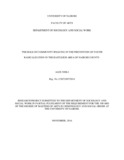| dc.description.abstract | Community policing approaches have been used successfully to prevent crime, reduce fear of crime, and improve public safety. A raging debate however is emerging as to whether this approach can be used with equal effectiveness in the prevention of terrorism. Like other Horn of Africa Countries, Kenya has over the last sixteen years tried several approaches on “the war against terrorism”. However, none of the approaches have succeeded in stamping out terrorism. The purpose of this study therefore was to find out ways in which the philosophy of community policing could be modeled to fit a citizen based-counter terrorism strategy in the Eastleigh area of Nairobi County. The study was based on four objectives; to identify risk factors that drive youth to radicalization, to establish the typical characteristics, features and behavioral patterns of radicalized youth and related activities; to establish how principles of community policing can assist in the identification of radicalized youth and to elicit suggestions on how to solve the problem of youth radicalization within Eastleigh area. This was done by exploring the role of police-community partnership in the prevention of youth radicalization to violent extremism. The study adopted a descriptive survey design. Questionnaires with both closed and open ended items were used to collect quantitative data from eighteen community-based entities which included religious groups, local business groups, welfare groups and Nyumba Kumi clusters. Interview schedules were used to collect qualitative data from five religious leaders and twelve police commanders. Systematic random sampling was used to pick respondents from various community groups and junior Police Commanders. Snowball and Purposive sampling were used in respect of religious leaders and senior police commanders respectively. Data was analyzed using descriptive statistics and themes. Analyzed data were presented in charts and tables. The study revealed that the current government‟s response to the threat of terrorism was largely based on „hard‟ policing techniques. However, such approaches were found to breed mistrust and hostility by residents towards law enforcement agencies. The study further established that community policing principles can be used to create sustainable partnerships between law enforcement agencies and local residents, thus facilitating the identification of root causes of youth radicalization. It was therefore recommended that an interagency approach should be employed to counter the threat of youth radicalization in addition to strengthening of critical governance structures; equitable distribution of national resources and the formation of a community based National Counter Terrorism Strategy. Training of police officers on community policing principles and trends in youth radicalization was strongly recommended. Further, police officers should invest more on trust building initiatives in establishing joint early warning system with the local communities they serve. The study further recommends an intensive public awareness campaign on the nature, indicators and symptoms of youth radicalization within Eastleigh in particular and the Country at large. | en_US |



